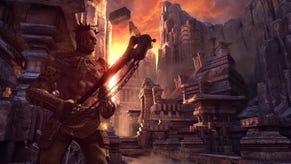Face-Off: Rage
Rage against the machines.
| - | Xbox 360 | PlayStation 3 |
|---|---|---|
| Disc Size | 7.6GB (disc one), 7.3GB (disc two), 6.7GB (disc three) | 20.3GB |
| Install | 7.6GB (disc one), 7.3GB (disc two), 6.7GB (disc three) | 7301MB (mandatory) |
| Surround Support | Dolby Digital | Dolby Digital, 5.1LPCM |
Get ready for something special with Rage - the first game from id software in almost six years, and its first multi-platform development project. Introducing its new Mega Texture technology, Rage opens up the possibility of incredibly complex, beautiful environments running at 60 frames per second on both Xbox 360 and PlayStation 3.
The result can be truly remarkable. When the player emerges from his hibernation ark at the beginning of the game and stumbles into the post-apocalyptic Wasteland, first impressions of the world id has created are breathtaking: nothing this rich, so detailed, so nuanced can run at 60FPS on console, right? What we're seeing is the id formula: the technological genius of John Carmack backed by the financial security that allows him and his team to branch out in new directions and only release the result "when it's done".
That said, it's been a long six years since Quake 4 came out, and it's safe to say that the industry today has transformed radically since the company's heyday. Carmack and id no longer define the roadmap of technological innovation - instead the fixed console architecture reigns supreme: the world surrounding id has changed irrevocably and the company has had to adapt to that. First impressions suggest that id has coped admirably: that jaw-dropping moment of exploring the Wasteland for the first time is just as powerful on both Xbox 360 and PlayStation 3, but does the quality of the experience remain as uniformly high as we progress through the game? Have Carmack and company mastered the arcane art of cross-platform development on their first attempt?
As usual, let's commence proceedings with a head-to-head video that compares the two console versions of the game, backed up by a triple-format comparison gallery.
Rage on console runs with a dynamic framebuffer that adjusts resolution according to engine load, but looks to run the game at as close to the full 1280x720 wherever possible. As you might expect from a game that operates at 60Hz, GPU time is at an absolute premium so neither version of the game features any kind of anti-aliasing, which is a bit of a shame as some of the more high contrast areas do lend themselves to noticeable "jaggies".
However, despite the limited 16.67ms available to render each frame, dynamic lighting is really effective and there's a wealth of post-process effects employed to give an extra layer of depth and atmosphere to any given scene. id doesn't just rely on the core beauty of the Mega Texture technology, instead supplementing it with a range of effects that might not have the complexity or fidelity of its competition, but really look the part and run beautifully at 60Hz. Perhaps the biggest noticeable drawback of the adherence to 60Hz is that dynamic shadows are thin on the ground: vanquished foes that drop into shadow remain lit by light sources unknown, and most of the environmental shadows are obviously "baked in" at the map creation phase.
It's fair to say that performance is very much at the heart of Rage, contributing to both its strengths and its weaknesses, but the one thing to make plain is that id hasn't gone for a COD-style perceptual 60FPS wherein a great deal of frames are dropped at will, with the hope that the player won't actually notice. The developer's focus has been on making this experience as consistent and exciting as possible.
First up, let's address the most positive aspect of the 60Hz implementation: the feel of the game. Most console video games run at 30 frames per second, introducing an inherent level of latency which isn't ideal but to which we have become accustomed. A typical 30FPS game has lag of anything between 100ms at best (unless we're talking about Need for Speed: Hot Pursuit) up to anything like 150ms. Factor in frame-rate drops and latency can creep even higher. On top of that, you need to add the additional delay incurred by your flatpanel monitor.
We measured Rage's input lag at an extremely consistent 83ms on Xbox 360, making the game feel that much more responsive than much of the competition, with Killzone 3 at 116ms and Bulletstorm at 133ms, for example. Now, what is truly remarkable here is just how well Rage sustains that 60Hz update and thus that rock-solid controller response. First up, let's take a look at a selection of clips concentrating on its first-person shooter elements, where pad response is arguably at its most important.
That's as close to a solid 60FPS as you're going to see all year - we couldn't find any duplicate frames at all on the PlayStation 3, while the tiny handful of dropped frames on Xbox 360 couldn't be seen by the human eye. Now compare and contrast that with Call of Duty: Black Ops and you'll have some idea of how much of a technical achievement it is for id software to be able to sustain that frame-rate, pretty much without fail, with this level of graphical detail.
Rage also has a very large driving component too - from various race types staged on pre-defined circuits to a very large, expansive game world you can explore at will. These sections spectacularly demonstrate the potential of id tech 5 in creating huge, tremendously detailed environments while mostly retaining the all-important 60FPS update. Here is where we see some deviation from the locked frame-rate we saw in the shooting sections: id allows itself to render out some lovely, often screen-filling explosive effects, and it's clear that the additional load on GPU fill-rate caused by this liberal application of full res alpha can prove to be too much - we see a momentary drop in performance plus screen-tear.
The effects are short-lived however and don't tend to impact on your enjoyment of the game at all - the screen-tear is definitely more noticeable than the frame-rate drop, but you get the idea this was all factored in and assessed by id. There's a feeling that its load balancing tech isn't quite so deeply applied in the driving sections as it is in the shooting - and it's almost certain that rendering the Wasteland offers far more of a challenge to the engine than the enclosed corridor shooting of most of the FPS missions.
Load balancing is the key to Rage's enviable performance profile. The developers have put frame-rate first to the point where the game code physically downscales the visuals to make it run at 60Hz. We understand the principle behind it and we can see the way it works simply by looking at the captures we've taken, but there remains an element of mystery in what actually causes the scaler to kick in, which we'll come to in a moment. In terms of the basic mechanics, Rage operates an internal monitor that measures engine load and when the renderer is in danger of missing a 60Hz refresh, it downscales the next frame. A 720p vertical resolution is always maintained, but the horizontal can be adjusted dynamically - anything from 640x720 (cutting image definition in half, basically) up to full-fat 1280x720.









